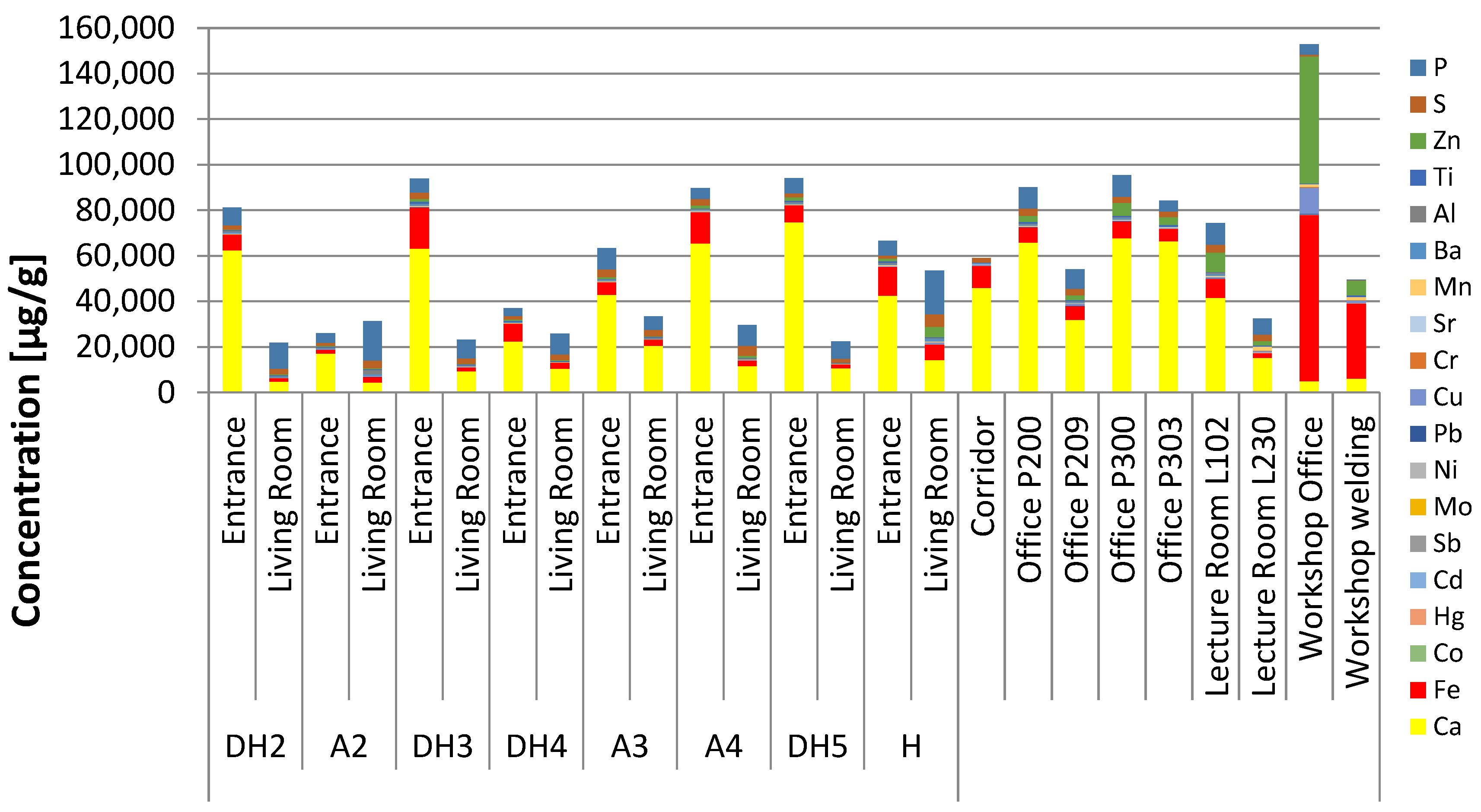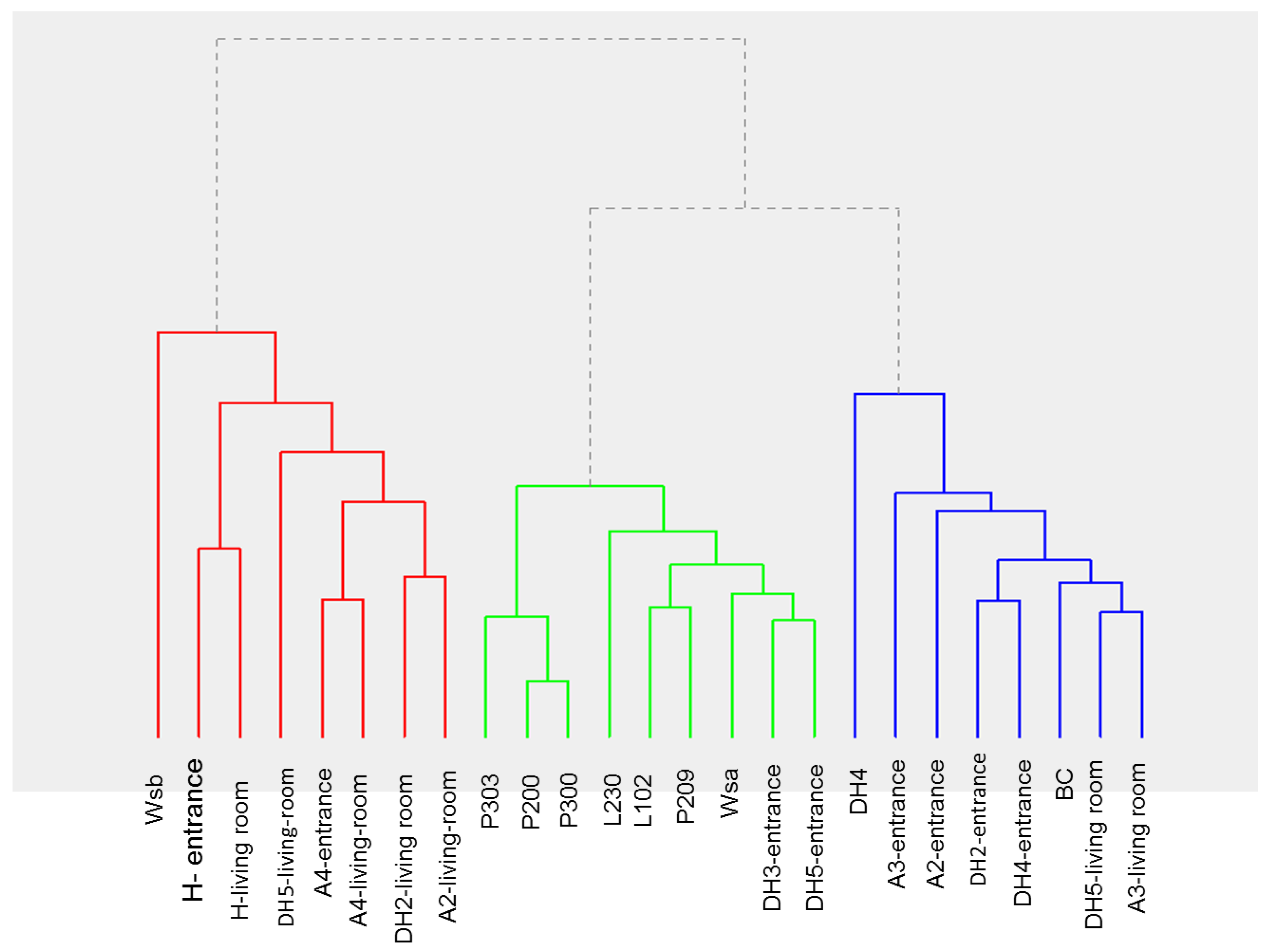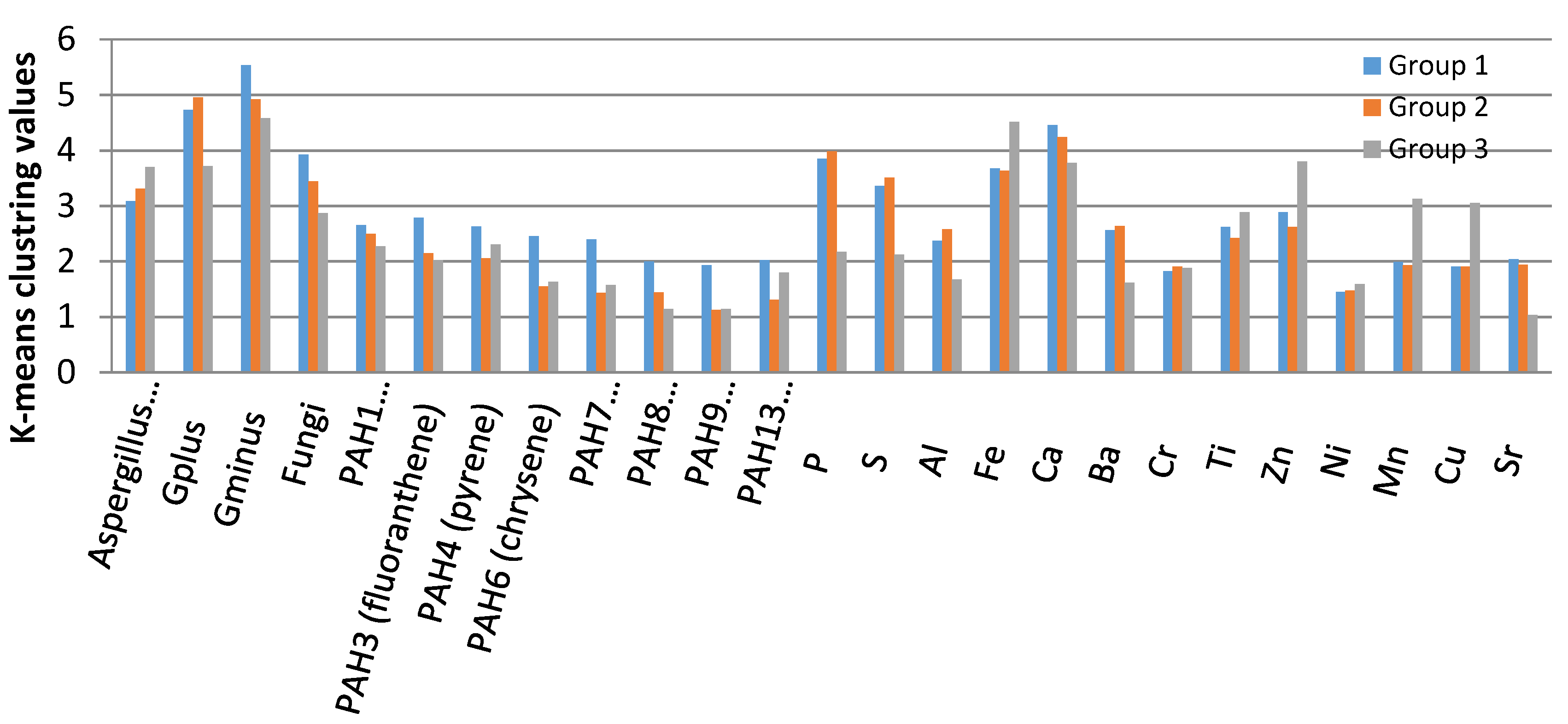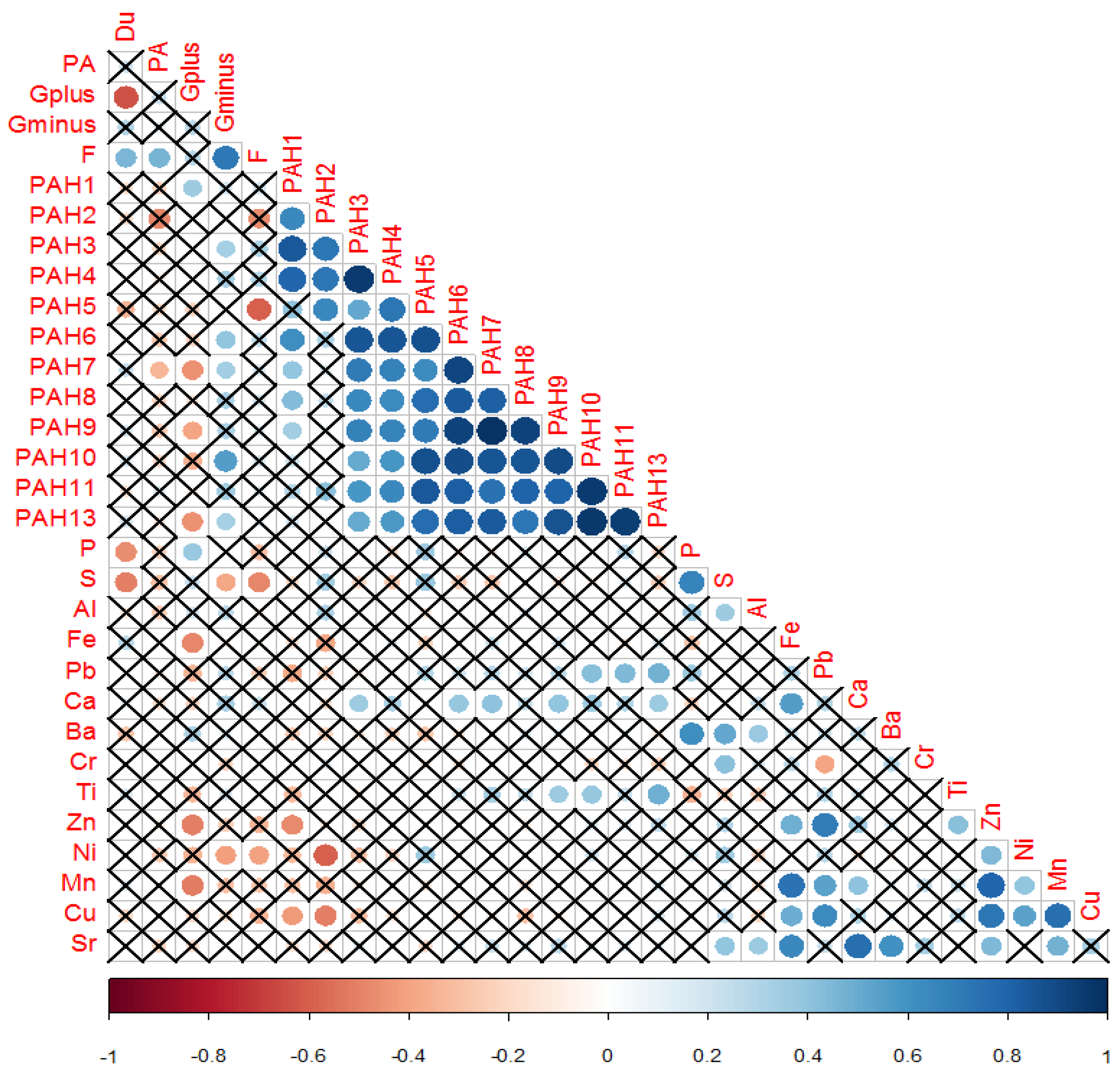Elemental Contamination in Indoor Floor Dust and Its Correlation with PAHs, Fungi, and Gram+/− Bacteria
Abstract
1. Introduction
2. Materials and Methods
2.1. Floor Dust Samples
2.2. Chemical and Biological Analysis
2.2.1. Elemental Analysis
2.2.2. PAHs and DNA Analysis
2.3. Enrichment Factor (EF)
2.4. Cluster Analysis
3. Results and Discussion
3.1. Elemental Concentrations and Enrichment Factor
3.2. Cluster Analysis and Intercorrelation of Pollutants
4. Conclusions
Supplementary Materials
Author Contributions
Funding
Acknowledgments
Conflicts of Interest
References
- Morawska, L.; Afshari, A.; Bae, G.N.; Buonanno, G.; Chao, C.Y.H.; Hänninen, O.; Hofmann, W.; Isaxon, C.; Jayaratne, E.R.; Pasanen, P.; et al. Indoor aerosols: From personal exposure to risk assessment. Indoor Air 2013, 23, 462–487. [Google Scholar] [CrossRef] [PubMed]
- Hulin, M.; Simoni, M.; Viegi, G.; Annesi–Maesano, I. Respiratory health and indoor air pollutants based on quantitative exposure assessments. Eur. Respir. J. 2012, 40, 1033–1045. [Google Scholar] [CrossRef] [PubMed]
- Yassin, M.F.; AlThaqeb, B.E.Y.; Al-Mutiri, E.A.E. Assessment of indoor PM2.5 in differentresidential environments. Atmos. Environ. 2012, 56, 65–68. [Google Scholar] [CrossRef]
- Hussein, T.; Kulmala, M. Indoor Aerosol Modeling: Basic Principles and Practical Applications. Water Air Soil Pollut. Focus 2008, 8, 23–34. [Google Scholar] [CrossRef]
- Hussein, T.; Wierzbicka, A.; Löndahl, J.; Lazaridis, M.; Hänninen, O. Indoor aerosol modelingfor assessment of exposure and respiratory tract deposited dose. Atmos. Environ. 2015, 106, 402–411. [Google Scholar] [CrossRef]
- Assessment of Combined Exposures to Multiple Chemicals: Report of a WHO/IPCS International Workshop on Aggregate/Cumulative Risk Assessment. World Health Organization. Available online: http://www.who.int/ipcs/methods/harmonization/areas/aggregate/en/index.html (accessed on 21 August 2019).
- Mercier, F.; Glorennec, P.; Thomas, O.; Bot, B.L. Organic Contamination of Settled House Dust, A Review for Exposure Assessment Purposes. Environ. Sci. Technol. 2011, 45, 6716–6727. [Google Scholar] [CrossRef] [PubMed]
- Sanborn, M.D.; Abelsohn, A.; Campbell, M.; Weir, E. Identifying and managing adverse environmental health effects: 3. Lead exposure. Can. Med. Assoc. J. 2002, 166, 1287–1292. [Google Scholar]
- Xing, Y.; Wang, J.; Xia, J.; Liu, Z.; Zhang, Y.; Du, Y.; Wei, W. A pilot study on using biochars as sustainable amendments to inhibit rice uptake of Hg from a historically polluted soil in a Karst region of China. Ecotoxicol. Environ. Saf. 2019, 170, 18–24. [Google Scholar] [CrossRef]
- Wang, J.; Xing, Y.; Xie, Y.; Meng, Y.; Xia, J.; Feng, A. The use of calcium carbonate-enriched clay minerals and diammonium phosphate as novel immobilization agents for mercury remediation: Spectral investigations and field applications. Sci. Total Environ. 2019, 646, 1615–1623. [Google Scholar] [CrossRef]
- Bruce, N.; Perez-Padilla, R.; Albalak, R. Indoor air pollution in developing countries: A majorenvironmental and public health challenge. Bull. World Health Organ. 2000, 78, 1078–1092. [Google Scholar]
- Lee, S.C.; Li, W.-M.; Ao, C.-H. Investigation of indoor air quality at residential homes in Hong Kong—Case study. Atmos. Environ. 2002, 36, 225–237. [Google Scholar] [CrossRef]
- Kurt-Karakus, P.B. Determination of heavy metals in indoor dust from Istanbul, Turkey: Estimation of the health risk. Environ. Int. 2012, 50, 47–55. [Google Scholar] [CrossRef] [PubMed]
- Tan Sock, Y.; Praveena Sarva, M.; Abidin Emilia, Z.; Cheema Manraj, S. A review of heavy metals in indoor dust and its human health-risk implications. Rev. Environ. Health 2016, 31, 447–456. [Google Scholar]
- Khoder, M.I.; Hassan, S.K.; El-Abssawy, A.A. An Evaluation of Loading Rate of Dust, Pb, Cd, and Ni and Metals Mass Concentration in the Settled Surface Dust in Domestic Houses and Factors Affecting Them. Indoor Built Environ. 2010, 19, 391–399. [Google Scholar] [CrossRef]
- Turner, A.; Hefzi, B. Levels and Bioaccessibilities of Metals in Dusts from an Arid Environment. Water Air Soil Pollut. 2010, 210, 483–491. [Google Scholar] [CrossRef]
- Dockery, D.; Pope, A. Epidemiology of Acute Health Effects: Summary of Time-Series Studies; Wilson, Spengler: Cambridge, MA, USA, 1996; pp. 123–147. [Google Scholar]
- Nriagu, J.O. A silent epidemic of environmental metal poisoning? Environ. Pollut. 1988, 50, 139–161. [Google Scholar] [CrossRef]
- Krantz, A.; Dorevitch, S. Metal exposure and common chronic diseases: A guide for the clinician. Dis. Mon. 2004, 50, 220–262. [Google Scholar] [CrossRef]
- Alam, M.J.; Anu, A.; Walk, S.T.; Garey, K.W. Investigation of potentially pathogenic Clostridium difficile contamination in household environs. Anaerobe 2014, 27, 31–33. [Google Scholar] [CrossRef]
- Grimsley, L.F.; Chulada, P.C.; Kennedy, S.; White, L.; Wildfire, J.; Cohn, R.D.; Mitchell, H.; Thornton, E.; El-Dahr, J.; Mvula, M.M.; et al. Indoor environmental exposures for children with asthma enrolled in the HEAL study, post-Katrina New Orleans. Environ. Health Perspect. 2012, 120, 1600–1606. [Google Scholar] [CrossRef]
- Considerations for Developing Alternative Health Risk Assessment Approaches for Addressing Multiple Chemicals, Exposures and Effect (External Review Draft). Available online: https://cfpub.epa.gov/ncea/risk/recordisplay.cfm?deid=149983 (accessed on 21 August 2019).
- Butte, W.; Heinzow, B. Pollutants in house dust as indicators of indoor contamination. Rev. Environ. Contam. Toxicol. 2002, 175, 1–46. [Google Scholar]
- Fergusson, J.E.; Kim, N.D. Trace elements in street and house dusts: Sources and speciation. Sci. Total Environ. 1991, 100, 125–150. [Google Scholar] [CrossRef]
- Rasmussen, P.E. Can Metal Concentrations in Indoor Dust be Predicted from Soil Geochemistry? Can. J. Anal. Sci. Spect. 2004, 49, 166–174. [Google Scholar]
- Hejami, A.A. Heavy Metals in Indoor Settled Dusts in Toronto, Canada. Master’s Thesis, Science in the Program of Molecular Science, Ryerson University, Toronto, ON, Canada, 2014. [Google Scholar]
- Turner, A. Oral bioaccessibility of trace metals in household dust: A review. Environ. Geochem. Health 2011, 33, 331–341. [Google Scholar] [CrossRef]
- Tong, S.T.Y.; Lam, K.C. Home sweet home? A case study of household dust contamination in Hong Kong. Sci. Total Environ. 2000, 256, 115–123. [Google Scholar] [CrossRef]
- Chattopadhyay, G.; Lin, K.C.-P.; Feitz, A.J. Household dust metal levels in the Sydney metropolitan area. Environ. Res. 2003, 93, 301–307. [Google Scholar] [CrossRef]
- Lau, W.K.Y.; Liang, P.; Man, Y.B.; Chung, S.S.; Wong, M.H. Human health risk assessment based on trace metals in suspended air particulates, surface dust, and floor dust from e-waste recycling workshops in Hong Kong, China. Environ. Sci. Pollut. Res. 2014, 21, 3813–3825. [Google Scholar] [CrossRef]
- Rustagi, N.; Singh, R. Mercury and health care. Indian J. Occup. Environ. Med. 2010, 14, 45–48. [Google Scholar]
- Madany, I.M.; Salim Akhter, M.; Al Jowder, O.A. The correlations between heavy metals in residential indoor dust and outdoor street dust in Bahrain. Environ. Int. 1994, 20, 483–492. [Google Scholar] [CrossRef]
- Charlesworth, S.; De Miguel, E.; Ordóñez, A. A review of the distribution of particulate trace elements in urban terrestrial environments and its application to considerations of risk. Environ. Geochem. Health 2011, 33, 103–123. [Google Scholar] [CrossRef]
- Rasmussen, P.E.; Subramanian, K.S.; Jessiman, B.J. A multi-element profile of house dust in relation to exterior dust and soils in the city of Ottawa, Canada. Sci. Total Environ. 2001, 267, 125–140. [Google Scholar] [CrossRef]
- Kefeni, K.K.; Okonkwo, J.O. Trace metals, anions and polybromodiphenyl ethers in settled indoor dust and their association. Environ. Sci. Pollut. Res. 2013, 20, 4895–4905. [Google Scholar] [CrossRef]
- Popoola, O.; Bamgbose, O.; Okonkwo, O.J.; Arowolo, T.; Popoola, A.; Awofolu, O. Heavy Metals Content in Classroom Dust of Some Public Primary Schools in Metropolitan Lagos, Nigeria. Res. J. Environ. Earth Sci. 2012, 4, 460–465. [Google Scholar]
- Al-Momani, I.F. Trace Elements in Street and Household Dusts in Amman, Jordan. Soil Sediment. Contam. Int. J. 2007, 16, 485–496. [Google Scholar] [CrossRef]
- Jaradat, Q.M.; Momani, K.A.; Jbarah, A.-A.Q.; Massadeh, A. Inorganic analysis of dust fall and office dust in an industrial area of Jordan. Environ. Res. 2004, 96, 139–144. [Google Scholar] [CrossRef]
- Al-Madanat, O.; Jiries, A.; Batarseh, M.; Al-Nasir, F. Indoor and Outdoor Pollution with Heavy Metals in Al-Karak City, Jordan. J. Int. Environ. Appl. Sci. 2017, 12, 131–139. [Google Scholar]
- Al-Rajhi, M.A.; Seaward, M.R.D.; Al-Aamer, A.S. Metal levels in indoor and outdoor dust in Riyadh, Saudi Arabia. Environ. Int. 1996, 22, 315–324. [Google Scholar] [CrossRef]
- Xiufeng, H.; Xinwei, L. Spatial distribution, environmental risk and source of heavy metals in street dust from an industrial city in semi-arid area of China. Arch. Environ. Prot. 2017, 43, 10–19. [Google Scholar]
- Al-Hunaiti, A.; Arar, S.; Täubel, M.; Wraith, D.; Maragkidou, A.; Hyvärinen, A.; Hussein, T. Floor dust bacteria and fungi and their coexistence with PAHs in Jordanian indoor environments. Sci. Total Environ. 2017, 601–602, 940–945. [Google Scholar] [CrossRef]
- Maragkidou, A.; Ma, Y.; Jaghbeir, O.; Alfaouri, D.; Harrad, S.; Al-Hunaiti, A.; Arar, S.; Hämeri, K.; Hussein, T. PAHs in Household Floor Dust Collected in Amman, Jordan. J. Chem. Eng. Process. Technol. 2016, 7, 1–6. [Google Scholar] [CrossRef]
- Maragkidou, A.; Arar, S.; Al-Hunaiti, A.; Ma, Y.; Harrad, S.; Jaghbeir, O.; Faouri, D.; Hämeri, K.; Hussein, T. Occupational health risk assessment and exposure to floor dust PAHs inside an educational building. Sci. Total Environ. 2017, 579, 1050–1056. [Google Scholar] [CrossRef]
- Chen, M.; Ma, L. Comparison of Three Aqua Regia Digestion Methods for Twenty Florida Soils. Soil Sci. Soc. Am. J. 2001, 65, 491–499. [Google Scholar] [CrossRef]
- 40 CFR Appendix B to Part 136—Definition and Procedure for the Determination of the Method Detection Limit–Revision 1.11. Available online: https://www.govinfo.gov/app/details/CFR–2011-title40-vol23/CFR–2011-title40-vol23-part136-appB (accessed on 1 July 2011).
- Sutherland, R.A.; Tolosa, C.A.; Tack, F.M.G.; Verloo, M.G. Characterization of Selected Element Concentrations and Enrichment Ratiosin Background and Anthropogenically Impacted Roadside Areas. Arch. Environ. Contam. Toxicol. 2000, 38, 428–438. [Google Scholar] [CrossRef]
- Chen, M.; Ma, L.Q. Comparison of Four USEPA Digestion Methods for Trace Metal Analysis Using Certified and Florida Soils. J. Environ. Qual. 1998, 27, 1294–1300. [Google Scholar] [CrossRef]
- Pam, A.; Sha’Ato, R.; Offem, J.O. Evaluation of heavy metals in soils around auto mechanic workshop clusters in Gboko and Makurdi, Central Nigeria. J. Environ. Chem. Ecotoxicol. 2013, 5, 298–306. [Google Scholar]
- Canadian Soil Quality Guidelines for the Protection of Environmental and Human Health. MERCURY (INORGANIC), 1999. Available online: https://www.elaw.org/es/system/files/canadiansoilqualitystandards.pdf (accessed on 1 September 1999).
- Al-Momani, I.F.; Shatnawi, W.M. Chemical Characterization and Source Determination of Trace Elements in PM2.5 and PM10 from an Urban Area, Northern Jordan. Int. J. Environ. Monit. Anal. 2017, 5, 103–108. [Google Scholar] [CrossRef][Green Version]
- Abed, A.M.; Al Kuisi, M.; Khair, H.A. Characterization of the Khamaseen (spring) dust in Jordan. Atmos. Environ. 2009, 43, 2868–2876. [Google Scholar] [CrossRef]
- Alori, E.T.; Glick, B.R.; Babalola, O.O. Microbial Phosphorus Solubilization and Its Potential for Use in Sustainable Agriculture. Front. Microbiol. 2017, 8. [Google Scholar] [CrossRef]
- Lee, N.; Jansen, J.; Aspegren, H.; Henze, M.; Nielsen, P.H.; Wagner, M. Population dynamics in wastewater treatment plants with enhanced biological phosphorus removal operated with and without nitrogen removal. Water Sci. Technol. 2002, 46, 163–170. [Google Scholar] [CrossRef]
- Arar, S.; Vinogradov, E.; Shewmaker, P.L.; Monteiro, M.A. A polysaccharide of Alloiococcus otitidis, a new pathogen of otitis media: Chemical structure and synthesis of a neoglycoconjugate thereof. Carbohydr. Res. 2008, 343, 1079–1090. [Google Scholar] [CrossRef]
- Pardo, R.; Herguedas, M.; Barrado, E.; Vega, M. Biosorption of cadmium, copper, lead and zinc by inactive biomass of Pseudomonas Putida. Anal. Bioanal. Chem. 2003, 376, 26–32. [Google Scholar] [CrossRef]
- Ma, L.; Terwilliger, A.; Maresso, A.W. Iron and zinc exploitation during bacterial pathogenesis. Metallomics 2015, 7, 1541–1554. [Google Scholar] [CrossRef]
- Iram, S.; Ahmad, I.; Javed, B.; Yaqoob, S.; Akhtar, K.; Kazmi, M.; Badar-uz-Zaman, D. Fungal tolerance to heavy metals. Pak. J. Bot. 2009, 41, 2583–2594. [Google Scholar]
- Anahid, S.; Yaghmaei, S.; Ghobadinejad, Z. Heavy metal tolerance of fungi. Sci. Iran. 2011, 18, 502–508. [Google Scholar] [CrossRef]
- Agency for Toxic Substances and Disease Registry (ATSDR) Case Studies in Environmental Medicine: Toxicity of Polycyclic Aromatic Hydrocarbons (PAHs). Available online: www.atsdr.cdc.gov/csem/csem.asp?csem=13&po=0 (accessed on 1 July 2009).






© 2019 by the authors. Licensee MDPI, Basel, Switzerland. This article is an open access article distributed under the terms and conditions of the Creative Commons Attribution (CC BY) license (http://creativecommons.org/licenses/by/4.0/).
Share and Cite
Arar, S.; Al-Hunaiti, A.; Masad, M.H.; Maragkidou, A.; Wraith, D.; Hussein, T. Elemental Contamination in Indoor Floor Dust and Its Correlation with PAHs, Fungi, and Gram+/− Bacteria. Int. J. Environ. Res. Public Health 2019, 16, 3552. https://doi.org/10.3390/ijerph16193552
Arar S, Al-Hunaiti A, Masad MH, Maragkidou A, Wraith D, Hussein T. Elemental Contamination in Indoor Floor Dust and Its Correlation with PAHs, Fungi, and Gram+/− Bacteria. International Journal of Environmental Research and Public Health. 2019; 16(19):3552. https://doi.org/10.3390/ijerph16193552
Chicago/Turabian StyleArar, Sharif, Afnan Al-Hunaiti, Mohanad H. Masad, Androniki Maragkidou, Darren Wraith, and Tareq Hussein. 2019. "Elemental Contamination in Indoor Floor Dust and Its Correlation with PAHs, Fungi, and Gram+/− Bacteria" International Journal of Environmental Research and Public Health 16, no. 19: 3552. https://doi.org/10.3390/ijerph16193552
APA StyleArar, S., Al-Hunaiti, A., Masad, M. H., Maragkidou, A., Wraith, D., & Hussein, T. (2019). Elemental Contamination in Indoor Floor Dust and Its Correlation with PAHs, Fungi, and Gram+/− Bacteria. International Journal of Environmental Research and Public Health, 16(19), 3552. https://doi.org/10.3390/ijerph16193552





